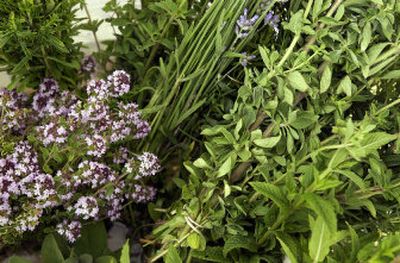Add spice to your life

The smell of fresh herbs, chopped to flavor a pot of winter stew, chili or the holiday turkey, has a very strong influence on most people I know. Cooks or gardeners alike, it draws people into the kitchen.
There are several ways to get and keep fresh herbs in your winter cooking.
First, there is always the grocery store. Many stores carry small packages of fresh herbs that are perfect for adding to the stew, herbed chicken or that fantastic recipe you bought a whole magazine for.
That’s all well and good if you remember to pick them up on your shopping run. What about the day the recipe idea hits you and the roads are a total mess? Of course the Grocery Law kicks in – you make the trek only to find they are out of what you needed.
This leaves one option; an indoor herb garden.
Some people might have started an herb garden with herbs brought in from the garden before it got cold. Hopefully they have settled in and are producing their flavorful leaves.
For those who don’t already have an indoor herb garden, it’s not too late to start one. You can have a few herbs for later in the winter and even next summer’s herb garden.
Some of the easiest herbs to start indoors include parsley, oregano, basil, chives, dill and sage. Spicy globe basil is a compact bushy plant that grows 8 to 10 inches tall. Dwarf fern leaf dill gets half the size of normal dill plant, perfect for indoors. Greek oregano gets about 10 to 12 inches tall and is the best for flavor.
Use 6-inch clay or plastic pots filled with a quality, fast draining potting mix. Larger pots will not dry out as quickly as the small ones you often find in kits. The pots must have drain holes.
Plant your seeds according to directions and water well. Create a mini-greenhouse by covering each pot loosely with a plastic bag held off the soil with a couple of chopsticks. Place the pots in a bright, warm place (70 to 75 degrees) and allow them to grow until some true leaves appear. Remove the bags and move them to their permanent space. Allow them to grow for a few weeks to create a strong plant.
Once you have a stocky, bushy plant, you can begin trimming off a few leaves at a time to use. Be careful not to clip too much as this weakens the plant and slows its growth. Experiment until you find a good balance. If you really like herbs, plant more than one pot of your favorites, so one plant can recover from a trimming while you are using the other.
Herbs grown indoors will need lots of bright light to produce a bountiful crop of leaves. South, east and west-facing windows that get sun most of the day are best. However, because our winter light is so low in the sky and we have many cloudy days, it is a good idea to also provide artificial light by installing some fluorescent lights. The lights need to be about a foot above the plants and set on a timer for about 15 hours a day.
No windows? Herbs can be grown completely under artificial light but probably won’t be as bushy.
Once grown, herb plants do well in normal household temperatures of 65 to 70 degrees as long as they aren’t in the drafts from heat vents or heavily used outside doors.
Proper watering is essential for good growth and finding the right balance will take some experimenting. As a rule, water most herbs when the soil is dry down to the first finger joint. Water enough to moisten the soil but do not leave standing water around the plant. Try to avoid using cold water straight out of the tap as this can shock the plants.
Herb plants benefit from higher humidity levels around them. Leaves that have higher moisture levels don’t dry out as quickly and can grow well. You can mist the plants regularly or you can simply group your plants on a tray of gravel filled with water. The evaporating water in the tray raises the humidity.
Fertilize lightly through the winter with a good balanced water soluble fertilizer. Check plants regularly for bugs, especially those that you brought in from your garden. If you find some, pick the affected leaves off rather than using anything to spray on – Remember, this is a food crop.